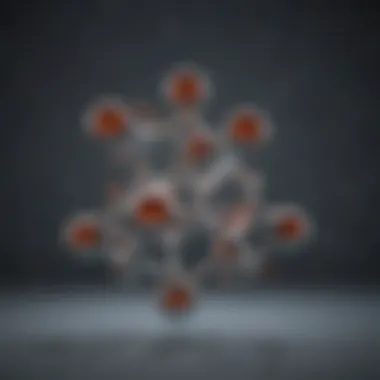Undecenoic Acid: Chemical Properties and Applications


Intro
Undecenoic acid is a carboxylic acid with the molecular formula C110O2. This compound has garnered attention for its various implications in scientific research and industrial applications. As it sits at the intersection of organic chemistry and biological science, understanding undecenoic acid's properties and roles becomes paramount for advancing both fields.
In recent years, research has illuminated its potential benefits in health, ecosystem dynamics, and even industrial processes. This underscores the necessity for a detailed examination of its chemical structure, synthesis pathways, and metabolic functions.
Prologue to Undecenoic Acid
Undecenoic acid holds considerable relevance in several scientific fields, making it an important subject in contemporary research. Understanding its properties is essential for students, researchers, educators, and professionals alike.
Definition and Overview
Undecenoic acid, a fatty acid with an eleven-carbon chain, is categorized among the unsaturated fatty acids due to the presence of a double bond. Its molecular formula is C110O2. The compound is mainly derived from the castor oil plant but can also be synthesized through various chemical reactions. Undecenoic acid is often recognized in scientific and industrial contexts due to its versatility. It serves as a precursor in the synthesis of complex organic compounds and demonstrates antifungal properties, further underscoring its significance in pharmaceuticals.
Historical Context
Undecenoic acid was first discovered in the early part of the twentieth century. Its properties were recognized during experiments aimed at understanding fatty acids better. In the years following its discovery, researchers began to explore its application in various fields, especially in medicine and agriculture. As knowledge about this compound expanded, studies began to highlight its effect on certain microbes, making it a candidate for therapeutic applications.
Research focusing on undecenoic acid intensified in recent decades, correlating with its potential as a biochemical agent in various applications. The evolving understanding of its structural attributes and functionalities has contributed to increased interest from scientists aiming to uncover its full potential. Much of the advancement in the study has led to recognition in both academic and industrial sectors, marking undecenoic acid as a compound warranting further exploration.
Chemical Structure of Undecenoic Acid
Understanding the chemical structure of undecenoic acid is vital for grasping its various implications in both biological and industrial contexts. The structural properties influence how this compound behaves, interacts with other molecules, and its overall efficacy in diverse applications. Each aspect of this structure contributes to the compound’s functionality, whether it is in industrial formulations or biological processes.
Molecular Formula and Mass
The molecular formula of undecenoic acid is C110O2. This implies that it contains eleven carbon atoms, twenty hydrogen atoms, and two oxygen atoms. The molecular mass of undecenoic acid is approximately 184.28 g/mol. This specific arrangement and the total weight are crucial for various applications, especially in the formulation of pharmaceuticals and cosmetic products. The mass plays an essential role in the calculations for dosages and concentrations when utilized in different industries.
Functional Groups
Undecenoic acid exhibits several key functional groups that greatly influence its chemical behavior. The most notable are the carboxylic acid group (-COOH) and the C=C double bond within the carbon chain.
- The carboxylic acid group is responsible for the acidic properties of undecenoic acid and its solubility in water.
- The double bond provides reactivity, enabling the compound to participate in various chemical reactions, such as polymerization and esterification.
The presence of these functional groups assists in determining the stability and reactivity of undecenoic acid under different conditions. This knowledge is vital as it informs scientists on how best to employ this substance in practical applications.
Isomerism
Isomerism is significant in the context of undecenoic acid, as it showcases the compound's potential versatility. Undecenoic acid can exist in different isomeric forms, most notably geometric isomers, owing to its double bond. This means that undecenoic acid can have different spatial arrangements which can affect its physical and chemical properties markedly.
- Cis Isomer: With groups on the same side of the double bond, often resulting in a more bent structure.
- Trans Isomer: With groups on opposite sides of the double bond, generally leading to a more linear structure.
Understanding these isomer types helps researchers to tailor undecenoic acid for specific applications, enhancing its performance. As researchers continue to delve into the nuances of undecenoic acid’s isomerism, the potential applications may further extend across various fields.
"The chemical structure of undecenoic acid is foundational to its applicational potential in diverse fields, from health to agriculture."
Through a detailed examination of these chemical aspects, we can appreciate why undecenoic acid is garnering growing interest in scientific communities worldwide.


Synthesis of Undecenoic Acid
The synthesis of undecenoic acid holds significant importance in understanding its applications and potential effects in various fields. Evaluating both natural and synthetic methods provides crucial insights into its availability, cost-effectiveness, and environmental implications. Furthermore, this section analyzes how these methods can cater to the demands in industries such as pharmaceuticals and agriculture. The careful consideration of different synthesis pathways sheds light on the ways undecenoic acid can be utilized effectively while addressing sustainability concerns.
Natural Sources
Undecenoic acid is available from several natural sources. Its origins include plants and certain fungi where it naturally occurs as a component of fatty acids. Notably, the oil from the castor bean plant contains undecenoic acid in small amounts. Other natural sources include the fermentation processes of specific bacteria and yeasts. These natural origins contribute to the acidity and unique properties of undecenoic acid. It plays a role in inhibiting fungal growth, thus making it relevant for diverse applications, especially in the agricultural sector. The natural extraction of undecenoic acid can also appeal to those looking for more sustainable and eco-friendly alternatives.
Synthetic Pathways
In addition to natural sources, synthetic pathways offer a reliable way to produce undecenoic acid. Various chemical reactions can be employed, often involving carbon chain elongation or oxidation processes. A common method involves the reaction of nonanoic acid with a suitable reagent to extend its carbon chain. Another popular synthesis approach includes catalytic processes which convert nonanoyl chloride to undecenoic acid. These synthetic pathways are vital because they allow the mass production of undecenoic acid necessary to meet industrial demands. They also offer the flexibility to tailor the synthesis conditions, ensuring that specific purity standards and yields are met based on the intended application.
Comparison of Methods
When considering the synthesis of undecenoic acid, it is important to compare natural and synthetic methods. Each method presents advantages and disadvantages, depending on the application requirements.
- Natural extraction: This method is generally more eco-friendly and can be considered sustainable. However, it often yields smaller amounts and can be variable in purity.
- Synthetic synthesis: This approach provides higher yields and the ability to control purity levels more effectively. However, it may involve the use of hazardous chemicals and solvents, raising environmental concerns.
Choosing between natural and synthetic methods requires a careful analysis of factors such as cost, yield, purity, and environmental impact. Understanding these elements allows industries to select the most appropriate method for producing undecenoic acid, aligning with their specific needs while considering broader environmental goals.
The versatility of undecenoic acid in different sectors underscores the importance of diverse synthesis methods to meet ongoing demand.
Biological Activity of Undecenoic Acid
The biological activity of undecenoic acid is a crucial area of exploration, given its potential implications for health, industry, and the environment. This section delves into its metabolism and absorption, physiological effects, and toxicity along with its safety profile. Understanding these aspects is essential for utilizing undecenoic acid effectively in various applications, making it a topic of significant interest among researchers and practitioners.
Metabolism and Absorption
Undecenoic acid undergoes various processes in the body once ingested. It is absorbed primarily in the gastrointestinal tract. The absorption efficiency may vary based on different factors, including the presence of other dietary components, which can either enhance or inhibit its uptake.
Once absorbed, undecenoic acid is metabolized through several pathways. The liver plays a crucial role, converting undecenoic acid into various metabolites. These metabolites can exert biological functions, influencing numerous physiological processes.
Factors affecting metabolism include:
- Age: Younger individuals often metabolize substances at different rates than older adults.
- Health Conditions: Conditions like liver disease can alter metabolic capacity.
- Drug Interactions: Certain medications may interfere with how undecenoic acid is metabolized.
Physiological Effects
The physiological effects of undecenoic acid are diverse. It has been observed to have antifungal properties, making it a candidate for treating fungal infections. Furthermore, some studies indicate that undecenoic acid may possess antimicrobial activity, positively affecting overall health.
Some known effects include:
- Antifungal Activity: Particularly against species such as Candida.
- Antimicrobial Properties: Impacts on various bacterial strains.
- Potential Role in Weight Management: Research suggests a link between undecenoic acid and lipolysis, the breakdown of fats in the body.
Amazingly, these physiological benefits open new avenues in agriculture, where undecenoic acid may be utilized as a natural pesticide due to its antimicrobial properties. Such applications further underscore the substance's versatility.
Toxicity and Safety Profile
Assessing the toxicity and safety of undecenoic acid is vital before its widespread application. Current research indicates that, at appropriate doses, undecenoic acid appears to have a favorable safety profile. In animal studies, only mild adverse effects have been reported. However, comprehensive human trials are still necessary to establish safe dosages and long-term effects.


Considerations for toxicity include:
- Dosage: Higher concentrations may lead to adverse effects.
- Sensitivity: Individual responses may vary based on genetic and health factors.
- Interactions: Potential interactions with other substances that may affect safety.
By understanding its biological activity, the scientific community can better harness the benefits of undecenoic acid. It further emphasizes the importance of thorough and meticulous research in expanding the understanding of such a multifaceted compound.
Applications of Undecenoic Acid
Undecenoic acid (UDA) has emerged as a compound of significant interest due to its diverse applications across various fields. Understanding UDA's applications is critical for researchers and professionals who are looking to explore its therapeutic potential, formulation in cosmetic products, and utility in agricultural practices. Each of these applications highlights the compound's versatile nature, underscoring its relevance in contemporary industry and research. The breaking down of UDA applications reveals both the current benefits and future possibilities.
Pharmaceutical Use
The pharmaceutical industry has recognized undecenoic acid for its antifungal properties. UDA acts effectively against certain types of yeast and molds, making it a valuable asset in the development of antifungal medications. Its role extends to the treatment of various skin infections caused by fungi, as well as in formulations that aim to maintain skin health.
The investigation into UDA also reveals its potential in treating other conditions. Some studies are exploring its ability to influence metabolic processes, which may lead to innovative approaches in metabolic disorders. Moreover, UDA's compatibility with other substances could enhance the effectiveness of existing medications.
Cosmetics and Personal Care
In the realm of cosmetics and personal care, undecenoic acid is notable for its role as a preservative and an antimicrobial agent. Consumers are increasingly conscious about the ingredients in their beauty products. UDA offers a natural alternative to synthetic preservatives, reducing the risk of skin irritation and other adverse effects. This is crucial for formulations targeted at sensitive skin.
Aside from preservation, UDA is also valued for its moisturizing properties. It can improve the texture and stability of creams and lotions. This multifaceted utility in personal care products emphasizes its relevance in meeting the growing consumer demand for safe and effective beauty solutions.
Agricultural Applications
Agriculturally, undecenoic acid shows promise as a biopesticide. Its antifungal properties can serve as a natural control method for plant pathogens. UDA can be integrated into pest management systems to reduce reliance on synthetic chemicals. This approach aligns with the increasing demand for sustainable agricultural practices.
Moreover, UDA's role in promoting plant health is being studied. The biochemical pathways influenced by this compound may enhance resistance to various stress factors in plants. This research might lead to innovative strategies in crop protection and yield improvement.
"The versatility of undecenoic acid allows it to meet the needs of diverse industries, illustrating its multifaceted potential in both health and agriculture."
In summary, undecenoic acid is a compound with broad applications across pharmaceuticals, cosmetics, and agriculture. Its benefits continue to be explored, paving the way for innovative solutions in these fields. The ongoing research could drive significant advancements, making UDA a pivotal component in future developments.
Regulatory and Environmental Considerations
The consideration of regulatory and environmental elements regarding undecenoic acid is crucial. This substance has promising applications across multiple fields, and its proper oversight ensures safety and efficacy. Regulatory frameworks are established to guide the use and study of substances like undecenoic acid. Additionally, understanding the environmental impact informs sustainable practices, making sure we consider future generations.
Regulatory Framework
The regulatory framework for undecenoic acid, like many chemicals, is vital for maintaining safety standards in its application. Various government agencies, including the Environmental Protection Agency (EPA) and the Food and Drug Administration (FDA), play roles in overseeing its use. These bodies assess the risks and benefits associated with undecenoic acid, determining its safety for human use and environmental release.
Compliance with regulations ensures that any product containing undecenoic acid adheres to safety guidelines, preventing adverse effects on individuals and ecosystems. The specifics of these regulations can vary by country, influencing how research and industrial applications are conducted.
Environmental Impact
Understanding the environmental impact of undecenoic acid is essential for evaluating its broader implications. This assessment includes how the substance interacts with ecosystems when released. Undecenoic acid has been explored for its potential as an environmentally friendly alternative to certain chemicals in agricultural applications. The low toxicity profile supports its use in environments where stronger chemicals pose risks.
- Biodegradability: Studies indicate that undecenoic acid may degrade more quickly than traditional solvents, reducing long-term environmental accumulation.
- Effects on Wildlife: Detailed studies must explore any potential risks to non-target species, ensuring that sustainable practices are followed.
- Ecosystem Interactions: Understanding how undecenoic acid interacts with various components of ecosystems can assist in preventing unintended consequences.


"Effective regulation is the starting point for evaluating the safety and impact of any chemical substance, ensuring that research and industry can progress responsibly."
Future Regulations
As scientific understandings evolve, future regulations concerning undecenoic acid may shift accordingly. Enhanced research can lead to updated guidelines that better reflect new findings about safety and effectiveness. Regulatory bodies often reassess substances based on emerging data, further guiding their application in industries.
- Increased Scrutiny: As demand for natural and less toxic chemicals rises, undecenoic acid may face increased evaluations.
- Guidelines for Use: Future regulations may include more defined guidelines on dosage and formulation in consumer products.
- Global Standards: Collaboration between nations may lead to more uniform standards that improve trade and safety practices across borders.
The landscape of regulations can shape the future of undecenoic acid's application, ensuring that advancements align with societal and environmental needs. Through mindful regulation, the future of undecenoic acid holds promise for innovation while maintaining a focus on safety and sustainability.
Current Research Trends
The exploration of undecenoic acid has surged in recent years, reflecting its potential across various fields. Current research trends focus on innovative synthesis processes, advancements in application studies, and the increasing incorporation of interdisciplinary approaches to deepen understanding and broaden its applications. This diverse approach is crucial as it not only enhances the scientific community's knowledge base but also informs practical applications that can benefit health, industry, and environmental science.
Innovations in Synthesis
Recent advances in the synthesis of undecenoic acid have emphasized more efficient and sustainable methods. Traditionally, synthesis involved complex multi-step reactions that often yielded lower purity and reduced overall efficiency. Newer methods, such as biocatalytic synthesis using enzymes and microbial techniques, are gaining traction. These processes tend to offer higher specificity and reduce the need for harsh chemical conditions.
Innovations also include the use of renewable feedstock which promotes sustainability. For example, researchers are investigating the use of fatty acids from algae and plant oils to produce undecenoic acid. The exploration of greener methods aligns with global trends toward sustainability and economic efficiency.
Advances in Application Research
As research progresses, the applications of undecenoic acid continue to expand. In pharmaceuticals, studies are delving deeper into its antifungal properties. This is particularly relevant in the context of drug resistance, where undecenoic acid presents a viable alternative due to its effectiveness against resistant microbial strains.
Moreover, its role in cosmetic formulations is also being highlighted. Researchers are examining its potential as a stabilizing agent in skin care products due to its biological activity. Such investigations are yielding promising results that could lead to enhanced formulations with better performance in skin health.
Furthermore, in agricultural science, undecenoic acid shows potential as a biopesticide and bioherbicide, amplifying its importance in sustainable farming practices. Its effectiveness in pest management can help reduce reliance on synthetic chemicals, providing a more eco-friendly agronomic strategy.
Interdisciplinary Studies
The recent focus on interdisciplinary studies is vital for progressing research on undecenoic acid. Collaborations among chemists, biologists, and environmental scientists enable a holistic understanding of this compound. By merging expertise from different scientific fields, researchers can explore the multifaceted roles of undecenoic acid more thoroughly.
Such interdisciplinary efforts are evident in projects that investigate undecenoic acid’s role in metabolic pathways, its effects on various biological systems, and its impact on human health. This comprehensive approach not only enriches the research but also uncovers potential connections and applications that may not have been observed in isolated studies.
"The combination of chemical synthesis, application research, and interdisciplinary collaboration is paving the way for significant advancements in the understanding of undecenoic acid."
End and Future Prospects
The exploration of undecenoic acid presents significant insights into its multifaceted roles in various scientific and industrial domains. This comprehensive examination underscores not only the chemical properties of undecenoic acid but also its biological relevance and potential applications. By synthesizing information from various sections of the article, it becomes evident that undecenoic acid is not just a simple compound but a material holding promise in health, industry, and environmental science.
Summary of Findings
This article has detailed various dimensions of undecenoic acid, including:
- Chemical Structure: Understanding its molecular formula and functional groups has opened avenues for further research.
- Synthesis: Both natural and synthetic pathways can provide insights into efficient manufacturing processes.
- Biological Activity: The metabolism and physiological effects demonstrate how vital undecenoic acid is for health.
- Applications: Its uses in pharmaceuticals, cosmetics, and agriculture show its potential for widespread impact.
- Regulatory Insights: The current regulatory landscape and environmental considerations are crucial for future developments.
- Research Trends: Recent innovations and interdisciplinary studies indicate a growing interest in undecenoic acid.
"Undecenoic acid represents a bridge between chemicals and biological significance, meriting more exploration in its multiple applications."
Potential for Further Study
The study of undecenoic acid is ripe for expanded exploration. Future research could focus on:
- Innovative Synthetic Techniques: Exploring greener synthesis methods could reduce environmental footprints and improve yield.
- Clinical Trials: More extensive trials on its physiological effects could validate its benefits in medical fields.
- Regulatory Development: Tracking how regulations adapt over time will be vital for leverage in industry applications.
- Interdisciplinary Approaches: Collaboration between chemists, biologists, and environmental scientists can unlock new potential uses for undecenoic acid.
- Market Expansion: Investigating new markets or applications in different industries may yield significant benefits.
In summary, further investigation into undecenoic acid can enhance understanding and lead to groundbreaking developments across various sectors.







